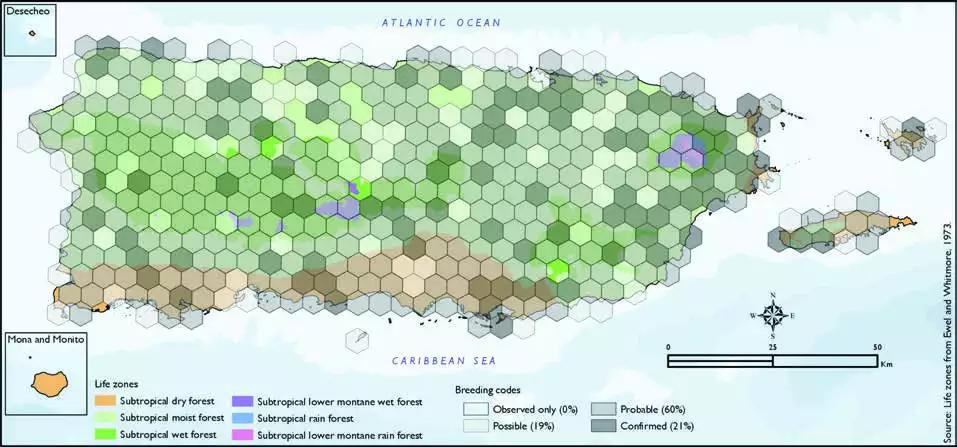Bananaquit
Description
The bananaquit (Coereba flaveola) is a species of passerine bird in the tanager family Thraupidae. Before the development of molecular genetics in the 21st century, its relationship to other species was uncertain and it was either placed with the buntings and New World sparrows in the family Emberizidae, with New World warblers in the family Parulidae or in its own monotypic family Coerebidae. This small, active nectarivore is found in warmer parts of the Americas, and is generally common.
Juvenile bananaquits are duller than adults, and may have yellow eyebrow and throat
Distribution & Habitat
The Bananaquit occurs throughout the West Indies,
as well as Central and South
America (Raffaele and others
1998). It is one of the most
common resident species
in Puerto Rico that occurs
throughout the island and
associated satellite islands
(Raffaele and others 1998).
However, it appears to be
absent from Mona, Monito, and
Desecheo islands (Terborgh and
Faaborg 1973, Ventosa-Febles
and others 2005). This species
occurs in most habitats including
urban areas and gardens, from
scrubland to tropical lowland
forest edges, but it is rare in
the highest mountain tops and
driest lowlands (Raffaele and
others 1998). The atlas fieldwork yielded a total of 1,101 records
within 418 hexagons or 87
percent of the 479 total hexagons
(see map). Of the 418 hexagons
where this species was found,
breeding met the atlas definition
of confirmed in 21 percent (87)
of the hexagons, probable in
60 percent (252), and possible in
19 percent (79) (see map). Bananaquit distribution. The map shows the highest breeding code by hexagon and overlaying the ecological life zones in
Puerto Rico. Note: percentages may not total 100 due to rounding.

Breeding Habits
The Bananaquit constructs a nest made of grass and fine
plant fiber year-round, but
primarily from March to June,
and following the seasonality
of rainfall, according to
previously published reports
(Raffaele and others 1998).
Atlas results indicate that
the breeding season extends
throughout the year, with a 281Bananaquit/Reinita Comúnpeak of breeding from March through June, as consistent with
previous literature (see chart).
The seasonal breeding pattern
appears to coincide in each of
the life zones with no evidence
to suggest breeding times differ
among the life zones. Results
show that this species breeds in
all of the ecological life zones,
but most of the breeding activity
was reported for the subtropical
moist forest life zone (59 percent
of the hexagons) that occupies
the largest portion of the island,
and also for the subtropical dry and subtropical wet forest life
zones (20 and 20 percent of the
hexagons, respectively) (see
table and map). Evidence of
breeding activity was reported
for only one hexagon in the
subtropical rain forest life zone.
Conservation
The population trend for the Bananaquit across its distribution
is stable, and it is listed as a
species of least concern by the
IUCN (BirdLife International
2016), while locally this species is not listed in any of the
threatened categories used
by PRDNER and USFWS. In
Puerto Rico, the Bananaquit
has a protected habitat in land
of 12 percent or 1183 km2 of the total area covered by the
hexagons where evidence of
breeding was found for this
species (~9972 km2). Note this area is larger than the total
terrestrial area of the island
because coastal hexagons and
those hexagons covering small
cays include a portion of water.
Related Species
Family:
tanager